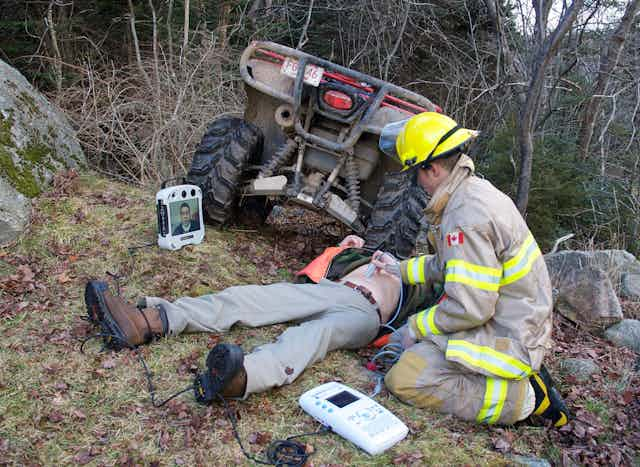It is the middle of the winter and a six-month-old child is brought with acute respiratory distress to a nursing station in a remote community in the Canadian North.
The nurse realizes that the child is seriously ill and contacts a pediatric intensivist located in a tertiary care centre 900 kilometres away. The intensivist uses her tablet to activate a remote presence robot installed in the nursing station and asks the robot to go to the assessment room.
The robot autonomously navigates the nursing station corridors and arrives at the assessment room two minutes later. With the help of the robot’s powerful cameras, the doctor “sees” the child and talks to the nurse and the parents to obtain the medical history. She uses the robot’s stethoscope to listen to the child’s chest, measures the child’s oxygen blood saturation with a pulse oximeter and performs an electrocardiogram.
With the robot’s telestrator (an electronic device which enables the user to write and draw freehand over a video image) she helps the nurse to start an intravenous line and commences therapy to treat the child’s life-threatening condition.
This is not science fiction. This remote presence technology is currently in use in Saskatchewan, Canada — to provide care to acutely ill children living in remote Northern communities.
Treating acutely ill children
Advances in telecommunication, robotics, medical sensor technology and artificial intelligence (AI) have opened the door for solutions to the challenge of delivering remote, real-time health care to underserviced rural and remote populations.

In Saskatchewan, we have established a remote medicine program that focuses on the care of the most vulnerable populations — such as acutely ill children, pregnant women and the elderly.
We have demonstrated that with this technology about 70 per cent of acutely ill children can be successfully treated in their own communities. In similar communities without this technology, all acutely ill children need to be transported to a tertiary care centre.
We have also shown that this technology prevents delays in diagnosis and treatment and results in substantial savings to the health-care system.
Prenatal ultrasounds for Indigenous women
Remote communities often lack access to diagnostic ultrasonography services. This gap disproportionally affects Indigenous pregnant women in the Canadian North and results in increases in maternal and newborn morbidity and mortality.
We are pioneering the use of an innovative tele-robotic ultrasound system that allows an expert sonographer to perform a diagnostic ultrasound study, in real time, in a distant location.
Research shows that robotic ultrasonography is comparable to standard sonography and is accepted by most patients.
The first tele-robotic ultrasonography systems have been deployed to two northern Saskatchewan communities and are currently performing prenatal ultrasounds.
Emergency room trauma assessment
Portable remote presence devices that use available cellular networks could also be used in emergency situations, such as trauma assessment at the scene of an accident or transport of a victim to hospital.
For example, emergency physicians or trauma surgeons could perform real-time ultrasonography of the abdomen, thorax and heart in critically injured patients, identify life-threatening injuries and start life-saving treatment.
Wearable remote presence devices such a Google Glass technology are the next step in remote presence health care for underserviced populations.
For example, a local nurse and a specialist in a tertiary care centre thousand of kilometres away could assess together an acutely ill patient in an emergency room in a remote community through the nurse’s eyes.

Although remote presence technology may be applied initially to emergency situations in remote locations, its major impact may be in the delivery of primary health care. We can imagine the use of mobile remote presence devices by health professionals in a wide range of scenarios — from home-care visits to follow-up mental health sessions — in which access to medical expertise in real time would be just a computer click away.
A paradigm shift in health-care delivery
The current model of centralized health care, where the patient has to go to a hospital or a clinic to receive urgent or elective medical care, is inefficient and costly. Patients have to wait many hours in emergency rooms. Hospitals run at overcapacity. Delays in diagnosis and treatment cause poor outcomes or even death.
Underserviced rural and remote communities and the most vulnerable populations such as children and the elderly are the most affected by this centralized model.
Remote presence technologies have the potential to shift this — so that we can deliver medical care to a patient anywhere. In this decentralized model, patients requiring urgent or elective medical care will be seen, diagnosed and treated in their own communities or homes and patients requiring hospitalization will be triaged without delay.
This technology could have important applications in low-resource settings. Cellular network signals around the globe and rapidly increasing bandwidth will provide the telecommunication platform for a wide range of mobile applications.
Low-cost, dedicated remote-presence devices will increase access to medical expertise for anybody living in a geographical area with a cellphone signal. This access will be especially beneficial to people in developing countries where medical expertise is insufficient or not available.
The future of medical care is not in building more or bigger hospitals but in harnessing the power of technology to monitor and reach patients wherever they are — to preserve life, ensure wellness and speed up diagnosis and treatment.

